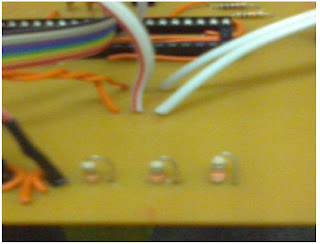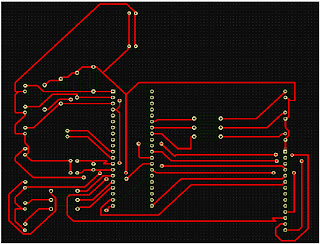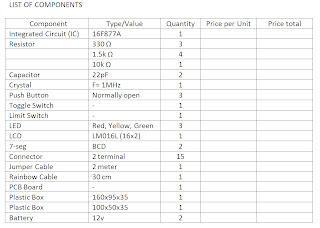Submission Components:
Library:
- Hard copy of Final Report with Hard Cover
- Soft copy of:
* Abstract.txt
* Final Report.pdf
* Technical Report .pdf
* Schematic & Program .rar
* Poster.jpg
* Picture.jpg
* Video.flv
Upload at http://rps.bmi.edu.my/fyp/submission/S112/Degree/51210209015 :
- Soft copy of:
* Abstract.txt
* Final Report.pdf
* Technical Report .pdf
* Schematic & Program .rar
* Poster.jpg
* Picture.jpg
* Video.flv
Submit at FYP Advisor ( Mr. Tan Yee Chyan )
- Hard copy of Final Report with Hard Cover
- Claim Receipt
NOTE: ALL OF THE SOFT COPY CAN BE FOUND AT
http://rps.bmi.edu.my/fyp/submission/S112/Degree/51210209015/index.php?studName=MUHAMMAD%20NADIY%20BIN%20ZAIAAMI&studId=51210209015
Friday, 18 May 2012
week 14: Presentation Day
Presentation Day:
assessor 1: Miss Shairah Wazir
assessor 2: Mr. Zulkifli B Mahmoodin
on presentation day, everything going smoothly .
student can answer the question confidently.
there are a lot of technical question.
Overall Project:
Video:
Poster:
assessor 1: Miss Shairah Wazir
assessor 2: Mr. Zulkifli B Mahmoodin
on presentation day, everything going smoothly .
student can answer the question confidently.
there are a lot of technical question.
Overall Project:
Video:
Poster:
week 13: Problem Occour
1- Capacitor
At the reset button, it have to make a parallel connection with the 220pF (104) ceramic capacitor. It is because to prevent multiple pulse give to the PIC16F877A. If the users press the reset button once, user has to wait the capacitor to be charged up before the second press. It is the law of capacitor to be charge and discharging. The knowledge of electronic components that student learn on previous semester have been applied.
2- LED and Resistor Priority
Simulation and actual device is not same. On the simulation, there are no tolerance and there are no disturbance. Everything are considered to be perfect. On Figure 3.9 there are a mistake that student do. For all know, the function of resistor is to prevent over current to LED. In this case, the circuit have to modified manually to avoid from making a new PCB. The arrangement of resistor and LCD are changed.
3- LCD
There are many type if 16x2 LCD. Each type of LCD have their own datasheet and connection. LCD must be grounded according to it’s pin. Wrong connection will display nothing except black and white screen on LCD. At first, student buy a VCM162A LCD. The result of the system is the LCD display a creepy character but it is working great on the other type of LCY which is JHD162A. With the insufficient time, the new LCD are replaced.
At the reset button, it have to make a parallel connection with the 220pF (104) ceramic capacitor. It is because to prevent multiple pulse give to the PIC16F877A. If the users press the reset button once, user has to wait the capacitor to be charged up before the second press. It is the law of capacitor to be charge and discharging. The knowledge of electronic components that student learn on previous semester have been applied.
2- LED and Resistor Priority
Simulation and actual device is not same. On the simulation, there are no tolerance and there are no disturbance. Everything are considered to be perfect. On Figure 3.9 there are a mistake that student do. For all know, the function of resistor is to prevent over current to LED. In this case, the circuit have to modified manually to avoid from making a new PCB. The arrangement of resistor and LCD are changed.
3- LCD
There are many type if 16x2 LCD. Each type of LCD have their own datasheet and connection. LCD must be grounded according to it’s pin. Wrong connection will display nothing except black and white screen on LCD. At first, student buy a VCM162A LCD. The result of the system is the LCD display a creepy character but it is working great on the other type of LCY which is JHD162A. With the insufficient time, the new LCD are replaced.
week 12: Soldering
Equipments:
1- soldering Iron
2- Sucker
3- wet spounge
4- hand drill
1- drill the pcb stand to make a task easier (drilling&soldering)
2- put the PCB stand
3- start drill the hole for components
4- solder all of the components according to the circuit design
week 11: Final PCB layout & Atching
Step to make a PCB:
1- print layout on Oscilloscope Plastic ( black and white)
2- iron the plastic on PCB board
3- adjust with marker the spot that did not have connection
4- boil a plain water
5- put an atching liquid in the Tupperware and add some hot water
6- wait for few munite
7- shake the Tupperware
8- wash the board with plain water
9- while washing the board with plain water, rub sand paper to remove the black ink from plastic and marker ink
10- finish
week 10: Final Program
#include
<16f877A.h>
#fuses HS,NOLVP,NOWDT,PUT
#use delay(clock=20000000)
#include <lcd.c>
#define GREEN_LED PIN_B2
#define YELLOW_LED PIN_B1
#define RED_LED PIN_B0
#define PUSH_BUTTON PIN_A0
#define PUSH_BUTTON2 PIN_A1
#define PUSH_BUTTON3 PIN_A2
#define BUZZER PIN_B4
#fuses HS,NOLVP,NOWDT,PUT
#use delay(clock=20000000)
#include <lcd.c>
#define GREEN_LED PIN_B2
#define YELLOW_LED PIN_B1
#define RED_LED PIN_B0
#define PUSH_BUTTON PIN_A0
#define PUSH_BUTTON2 PIN_A1
#define PUSH_BUTTON3 PIN_A2
#define BUZZER PIN_B4
#INT_RB
//Interrupts from Pins B4
void
RB_ISR( )
{ disable_interrupts(INT_RB);
while (!input(PIN_B7)) //Detect Pin B7
while (!input(PIN_B7)) //Detect Pin B7
{
lcd_init( );
{ lcd_putc("\fHELP!!!!");
delay_ms(5);
}
{ lcd_putc("\fHELP!!!!");
delay_ms(5);
}
output_low(BUZZER);
delay_ms (200);
output_high(BUZZER);
delay_ms (200);
output_low(BUZZER);
delay_ms (200);
}
delay_ms (200);
output_high(BUZZER);
delay_ms (200);
output_low(BUZZER);
delay_ms (200);
}
clear_interrupt(INT_RB);
enable_interrupts(INT_RB);
enable_interrupts(INT_RB);
}
void
wait_for_one_press( )
{ while(!input(PUSH_BUTTON)) ;
while(input(PUSH_BUTTON)) ; //Wait for one press
}
while(input(PUSH_BUTTON)) ; //Wait for one press
}
void
light_one_led(int led)
{ output_high(RED_LED);
output_high(YELLOW_LED);
output_high(GREEN_LED);
output_high(YELLOW_LED);
output_high(GREEN_LED);
switch(led)
{ case 0 : output_low(RED_LED); break;
case 1 : output_low(YELLOW_LED); break;
case 2 : output_low(GREEN_LED); break;
}
{ case 0 : output_low(RED_LED); break;
case 1 : output_low(YELLOW_LED); break;
case 2 : output_low(GREEN_LED); break;
}
}
void main()
{
int count = 0;
set_tris_b(0xFF); // set up port b
port_b_pullups(TRUE); //Enable pull up resistors for Port B
clear_interrupt(INT_RB);
enable_interrupts(INT_RB); //Enable Port B4-7 interrupts
enable_interrupts(GLOBAL); //Enable all interrupts
EXT_INT_EDGE(H_TO_L); // interrupt on falling edge
set_tris_b(0xFF); // set up port b
port_b_pullups(TRUE); //Enable pull up resistors for Port B
clear_interrupt(INT_RB);
enable_interrupts(INT_RB); //Enable Port B4-7 interrupts
enable_interrupts(GLOBAL); //Enable all interrupts
EXT_INT_EDGE(H_TO_L); // interrupt on falling edge
lcd_init( );
{ lcd_putc("\fmy name is NADIY\npush to JUMP");
delay_ms(50);
}
{ lcd_putc("\fmy name is NADIY\npush to JUMP");
delay_ms(50);
}
{ wait_for_one_press();
light_one_led(0);
delay_ms(1000);
light_one_led(1);
delay_ms(1000);
light_one_led(2);
delay_ms(1000);
light_one_led(0);
delay_ms(1000);
light_one_led(1);
delay_ms(1000);
light_one_led(2);
delay_ms(1000);
}
while(TRUE) {
lcd_init( );
lcd_putc("\fWelcome to FYP\n");
printf (lcd_putc,"LAP = %U",count);
delay_ms(300);
wait_for_one_press( );
count++;
if(count>99)
count = 0;
}
}
week 9: Design of Power Supply
Microcontroller,
LCD, LED and relay driver chip need a 5V dc. So the power supply for electronic
circuit was 5V dc. Microcontroller needs 5V dc to activate the chip and provide
signal. Power supply from 9V dc battery
regulated by voltage regulator to 5V dc
as required for the circuit.
Voltage must be
regulated to 5V dc by using voltage regulator LM 7805. This voltage regulator
can withstand of input high from 35V dc regulate to produce an output of 5V. It
also requires heat sink to protect the device from damage due to overheat. When
it was operated, it produces a lot of heat.
week 8: Final circuit (Proteus)
- Because of some technical problem, the circuit have to modified.
- There are direct connection between components to avoid miss-connection on actual device.
- There are direct connection between components to avoid miss-connection on actual device.
Monday, 20 February 2012
Wednesday, 15 February 2012
week 5: Low Cost Multipurpose Swimmer Helper Using PIC 16F877A
Those fortune enough to swim 50-metre pool don't have to count very many length in order to cover a reasonable distance. for example, just 20 length means that you have swum a kilometre. but even then, as you plough up and down the pool, it is pretty easy to get distracted and lose count. some people cope with the problem by swimming five length freestyle, five breast-stroke, five back-stroke and so on.
The problem is worse if you are swimming in a 25-metre pool (as many top-level swimmers regularly train in) and much worse in you're swimming in a small pool, which may be only 10 or 15 meters long. for a 10-metre pool, you need to do a 100 lengths to cover a kilometer.
it is impossible to trying to keep track of that many lengths in small pool while you swim back and forth is practically impossible. this is where Low Cost Multipurpose Swimmer Helper Using PIC 16F877A are applied. it will display the number of lengths that you have completed on a 2-digit readout, so you can let your mind wander, do a mental arithmetic or compose your new symphony while you swim up and down. this device also have an indicator light to help a swimmer to get ready to start. by using a LCD display, it make this device a friendly device.
This Low Cost Multipurpose Swimmer Helper Using PIC 16F877A consists of two small plastic boxes. one of the box contain the main circuit and the 2-digit readout. while the other one are contains the switch that the user have to push to count their lap.
The way it works is as follows. you place the switch at the far end of the pool (from where you normally start). before you dive on (or gingerly wade in) push the button once, ti will give 3 indicator light which is red (on your mark), yellow (get set), and green (go!!!), swim to the other end and push the button, where upon the display indicates '01'. congratulations, you have complied one lap.
This Low Cost Multipurpose Swimmer Healper Using PIC 16F877A also have a timer function. the timer function is to count how long the user can hold their breath. some style of swimming require you to dive, the longer you can dive is the better. before user dive, user have to push the button once, and this device will start to count the time. when user up to get the air, push once again. the time of user dive will be display on the LCD screen.
In some case, lifeguard did not notice that there are an accident. if suddenly your leg are cramped or you saw someone are drowning in water, you can push a panic button to call a lifeguard. logically, to compare the person who in the water and person that out of the pool, the person out of the pool are faster to get the drowning person
The problem is worse if you are swimming in a 25-metre pool (as many top-level swimmers regularly train in) and much worse in you're swimming in a small pool, which may be only 10 or 15 meters long. for a 10-metre pool, you need to do a 100 lengths to cover a kilometer.
it is impossible to trying to keep track of that many lengths in small pool while you swim back and forth is practically impossible. this is where Low Cost Multipurpose Swimmer Helper Using PIC 16F877A are applied. it will display the number of lengths that you have completed on a 2-digit readout, so you can let your mind wander, do a mental arithmetic or compose your new symphony while you swim up and down. this device also have an indicator light to help a swimmer to get ready to start. by using a LCD display, it make this device a friendly device.
This Low Cost Multipurpose Swimmer Helper Using PIC 16F877A consists of two small plastic boxes. one of the box contain the main circuit and the 2-digit readout. while the other one are contains the switch that the user have to push to count their lap.
The way it works is as follows. you place the switch at the far end of the pool (from where you normally start). before you dive on (or gingerly wade in) push the button once, ti will give 3 indicator light which is red (on your mark), yellow (get set), and green (go!!!), swim to the other end and push the button, where upon the display indicates '01'. congratulations, you have complied one lap.
This Low Cost Multipurpose Swimmer Healper Using PIC 16F877A also have a timer function. the timer function is to count how long the user can hold their breath. some style of swimming require you to dive, the longer you can dive is the better. before user dive, user have to push the button once, and this device will start to count the time. when user up to get the air, push once again. the time of user dive will be display on the LCD screen.
In some case, lifeguard did not notice that there are an accident. if suddenly your leg are cramped or you saw someone are drowning in water, you can push a panic button to call a lifeguard. logically, to compare the person who in the water and person that out of the pool, the person out of the pool are faster to get the drowning person
week 4: unfinished program for propose title
This program are build in PICC compiler
#include <16f877A.h>
#include <lcd.c>
#fuses HS,NOLVP,NOWDT,PUT
#use delay(clock=20000000)
#define GREEN_LED PIN_B2
#define YELLOW_LED PIN_B1
#define RED_LED PIN_B0
#define PUSH_BUTTON PIN_A0
#define PUSH_BUTTON2 PIN_A1
#define PUSH_BUTTON3 PIN_A2
void wait_for_one_press()
{ while(!input(PUSH_BUTTON)) ;
while(input(PUSH_BUTTON)) ; //Wait for one press
}
void light_one_led(int led)
{
output_high(RED_LED);
output_high(YELLOW_LED);
output_high(GREEN_LED);
switch(led)
{
case 0 : output_low(RED_LED); break;
case 1 : output_low(YELLOW_LED); break;
case 2 : output_low(GREEN_LED); break;
}
}
void main()
{ int count = 0;
{ wait_for_one_press();
light_one_led(0);
delay_ms(100);
light_one_led(1);
delay_ms(100);
light_one_led(2);
delay_ms(100);
{
while(TRUE)
{ output_c((count/10<<4)+(count%10));
delay_ms(5);
wait_for_one_press();
count++;
if(count>99)
count = 0;
}
}
void wait_for_one_press2( )
{ while(!input(PUSH_BUTTON2)) ;
while(input(PUSH_BUTTON2)) ; //Wait for one press
}
void main2( )
{ int count = 0;
lcd_init( );
while(TRUE)
{ lcd_putc("\fWelcome to my FYP\n");
printf (lcd_putc,"Count = %U",count);
delay_ms(250);
wait_for_one_press2( );
count++;
if(count>99)
count = 0;
}
}
#include <16f877A.h>
#include <lcd.c>
#fuses HS,NOLVP,NOWDT,PUT
#use delay(clock=20000000)
#define GREEN_LED PIN_B2
#define YELLOW_LED PIN_B1
#define RED_LED PIN_B0
#define PUSH_BUTTON PIN_A0
#define PUSH_BUTTON2 PIN_A1
#define PUSH_BUTTON3 PIN_A2
void wait_for_one_press()
{ while(!input(PUSH_BUTTON)) ;
while(input(PUSH_BUTTON)) ; //Wait for one press
}
void light_one_led(int led)
{
output_high(RED_LED);
output_high(YELLOW_LED);
output_high(GREEN_LED);
switch(led)
{
case 0 : output_low(RED_LED); break;
case 1 : output_low(YELLOW_LED); break;
case 2 : output_low(GREEN_LED); break;
}
}
void main()
{ int count = 0;
{ wait_for_one_press();
light_one_led(0);
delay_ms(100);
light_one_led(1);
delay_ms(100);
light_one_led(2);
delay_ms(100);
{
while(TRUE)
{ output_c((count/10<<4)+(count%10));
delay_ms(5);
wait_for_one_press();
count++;
if(count>99)
count = 0;
}
}
void wait_for_one_press2( )
{ while(!input(PUSH_BUTTON2)) ;
while(input(PUSH_BUTTON2)) ; //Wait for one press
}
void main2( )
{ int count = 0;
lcd_init( );
while(TRUE)
{ lcd_putc("\fWelcome to my FYP\n");
printf (lcd_putc,"Count = %U",count);
delay_ms(250);
wait_for_one_press2( );
count++;
if(count>99)
count = 0;
}
}
week 3: propose of new title
Low Cost Multipurpose Swimmer Helper Using PIC 16F877A
>>>Features
- Lap counter
- breath hold timer
- S.O.S. system for life guard
>>>Circuit Design
- Clock for ic
- Insert reset button
- Switches
- Led (on your mark, get set, go!!!!)
- 7-segment for Lap Counter
- LCD display for welcome display and timer
- Labeling the circuit
>>>Features
- Lap counter
- breath hold timer
- S.O.S. system for life guard
>>>Circuit Design
- Clock for ic
- Insert reset button
- Switches
- Led (on your mark, get set, go!!!!)
- 7-segment for Lap Counter
- LCD display for welcome display and timer
- Labeling the circuit
week 2:: problem
problem on circuit design
i had try to design the circuit, but i did knot know how to design
- what is the input
- how to get the input
- how to generate input
- it is different from the example; on example the IC is 18f132ML
on program i did know how to start
- how to initialize
- how to determine the input
Sunday, 29 January 2012
Week 1
- On 26th January, there are a briefing about Final Year Project at Gemilang Hall.
- That briefing were for student FYP 1 and FYP 2
- Student are told about what they have to do for this semester by in charged lecturer
- Student have to make their own blog for their project
- Student also assisted by lecturer
- After that there are a meeting with supervisor
- Supervisor advice student to do the simulation first before buy any component
- On 26th January, there are a briefing about Final Year Project at Gemilang Hall.
- That briefing were for student FYP 1 and FYP 2
- Student are told about what they have to do for this semester by in charged lecturer
- Student have to make their own blog for their project
- Student also assisted by lecturer
- After that there are a meeting with supervisor
- Supervisor advice student to do the simulation first before buy any component
Subscribe to:
Comments (Atom)


































